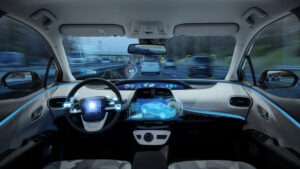
The safety of self-driving cars continues to be a topic of debate as these autonomous vehicles continue to gain prominence. While proponents argue that self-driving cars can drastically reduce accidents caused by human error, critics point to the system’s ability to handle unexpected situations, raising questions about their safety.
At Vaughan & Vaughan, we stay at the forefront of the personal injury law. Our legal team offers personalized legal assistance to all injured victims in Indiana. A car accident lawyer in Indianapolis will review your legal options and create a tailored legal strategy for your case. Call our law firm today to schedule a free initial consultation.
Understanding Self-Driving Cars
Self-driving cars, also known as autonomous vehicles or driverless cars, represent a groundbreaking technological advancement in the automotive industry. While they promise a safer and more convenient mode of travel, some argue that this is not the case, or at least not yet.
Levels of Autonomy
At the heart of self-driving cars is their ability to operate without human intervention. The Society of Automotive Engineers (SAE) has established a widely recognized framework for categorizing the levels of autonomy in these vehicles, ranging from Level 0 (no automation) to Level 5 (full automation).
The following table illustrates the levels of autonomy in vehicles:
| Level of Autonomy | Description | Example |
| Level 0 | No automation | Traditional vehicles controlled entirely by a human driver. |
| Level 1 | Driver assistance | Vehicles equipped with systems like adaptive cruise control and lane-keeping assistance. |
| Level 2 | Partial automation | Cars capable of controlling both steering and acceleration/deceleration concurrently. |
| Level 3 | Conditional automation | Vehicles that can handle most driving tasks but require human intervention in emergencies. |
| Level 4 | High automation | Self-driving cars capable of fully autonomous operation in specific conditions. |
| Level 5 | Full automation | Vehicles that can operate autonomously under all conditions without human intervention. |
Key Technologies Involved
Self-driving cars rely on a sophisticated combination of cutting-edge technologies to perceive their surroundings and make real-time driving decisions, which, in theory, can significantly enhance safety on the roads.
Some of the key technologies involved include:
- Sensors: Self-driving cars are equipped with an array of sensors, including Light Detection and Ranging (LiDAR), radar, cameras, and ultrasonic sensors. These sensors provide a 360-degree view of the vehicle’s surroundings, helping it detect and react to objects, pedestrians, and other vehicles.
- GPS and Mapping: GPS technology and highly detailed maps enable self-driving cars to pinpoint their location with exceptional accuracy. These maps provide essential information about road geometry, traffic signs, and other critical data.
- Artificial Intelligence (AI): Advanced AI algorithms process data from sensors and maps to make real-time driving decisions. Machine learning allows these systems to improve performance over time through experience and data analysis.
- Connectivity: Self-driving cars often rely on communication networks to exchange data with other vehicles (V2V) and infrastructure (V2I). This connectivity allows the vehicle to visualize road conditions, enhancing safety and coordination.
While the potential safety benefits of self-driving cars are substantial, these systems are not infallible, and there are still challenges to overcome. The ability to handle unexpected situations, ethical dilemmas, and the need for comprehensive testing are among the critical factors that need to be addressed to ensure that self-driving cars live up to their safety promise.
Your Case Will Get
The Attention It Deserves

Safety Standards for Self-Driving Vehicles
Safety standards for self-driving vehicles are essential as autonomous technology continues to evolve. These standards aim to ensure the safety of passengers, pedestrians, and all road users while providing a framework for manufacturers and developers.
Safety standards encompass a wide range of aspects, including:
- Design and performance of self-driving systems
- Testing and validation procedures
- Cybersecurity measures
- Data privacy
Regulatory bodies and organizations, such as the National Highway Traffic Safety Administration (NHTSA) in the United States and the European Union, have been working to establish and update these standards.
Facing the Unexpected: Self-Driving Cars and Edge Cases
One of the central concerns revolves around the technology’s ability to navigate unanticipated scenarios effectively. Self-driving cars rely on intricate sensors, algorithms, and AI systems to make split-second decisions on the road. However, their ability to handle unexpected situations, such as sudden obstacles or unusual traffic scenarios, remains a contention.
While proponents argue that the precision and consistency of these systems could outperform human drivers, critics contend that the lack of human intuition and adaptability can be a hindrance in unprecedented circumstances.
The safety of self-driving cars ultimately hinges on their capacity to learn from these situations, improve their responses, and, most importantly, protect the well-being of passengers, pedestrians, and other road users.


Call a Car Accident Lawyer Today
At Vaughan & Vaughan, we understand the importance of staying up-to-date with evolving technology and its implications for personal injury cases. As the legal landscape adapts to accommodate self-driving cars, our legal team remains committed to advocating for the rights of those affected by accidents involving autonomous vehicles.
If you or a loved one were injured in a crash, our car accident lawyers will help you navigate the legal aftermath. Contact us today to discuss your options.




